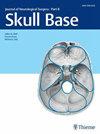内窥镜鼻内神经外科手术培训:对现有模式的系统回顾
IF 0.9
4区 医学
Q3 Medicine
引用次数: 0
摘要
背景熟练掌握内窥镜鼻内镜神经外科手术(EEN)需要一套独特的技能,而且学习曲线陡峭。内窥镜模拟模型为学员提供了一个在无风险环境中提高手术技能和解剖知识的机会。目的分析每种内镜培训模式的特点、优缺点,描述模拟培训的各个阶段,并提出内镜培训的未来方向和算法。方法对2023年8月之前发表的研究进行全面检索。在检索和选择纳入的研究时,遵循了系统综述和荟萃分析首选报告项目(PRISMA)指南。检索标题和摘要的术语为("模拟")和("内窥镜内腔")和("神经外科")。结果我们共找到 176 篇参考文献,43 项研究符合纳入标准。12篇文章描述了尸体模型,其中7篇研究了颈内动脉损伤(ICAI)管理,3篇研究了脑脊液漏管理;14篇文章说明了合成模型,1篇文章描述了动物模型,16篇文章概述了虚拟现实(VR)模拟。结论髋臼模型能以可接受的成本提供逼真的手术实训,仍然是培训的黄金标准方法。合成模型对术前手术规划最有效,动物模型最适合用于止血技术测试。VR 模拟可能会成为新手获取基本解剖知识的主要培训工具,因为它们在高级手术规划中的作用正在不断发展。本文章由计算机程序翻译,如有差异,请以英文原文为准。
Training in Endoscopic Endonasal Neurosurgical Procedures: a Systematic Review of Available Models
Background
Proficiency in endoscopic endonasal neurosurgery (EEN) requires a unique skill set and is associated with a steep learning curve. Endoscopic simulation models present an opportunity for trainees to enhance their surgical skills and anatomical knowledge in a risk-free environment. To date, four main categories of training modalities have been recorded: cadaveric, synthetic, animal, and virtual reality (VR) models.
Objective
To analyze the features, advantages, and disadvantages of each EEN training model, describe the stages of simulation training, and propose future directions and an algorithm for EEN training.
Methods
A comprehensive search was performed including studies published before August 2023. Preferred Reporting Items for Systematic Reviews and Meta-analyses (PRISMA) guidelines were followed in the search and selection of studies included. Terms for searching title and abstract were (“simulation”)AND(“endoscopic endonasal”)AND(“neurosurgery”). Articles were screened for duplicates.
Results
We identified 176 references, and 43 studies met the inclusion criteria. Twelve articles described cadaveric models, with 7 of them studying internal carotid artery injury (ICAI) management and 3 of them CSF leak management; fourteen articles illustrated synthetic models, one article described animal models, and sixteen articles outlined virtual reality (VR) simulations.
Conclusion
Cadaveric models provide realistic hands-on surgical training with acceptable cost and remain the gold standard method for training. Synthetic models are most effective for preoperative surgical planning and animal models are best suited for testing of hemostatic techniques. VR simulations may become the primary training tool for novices to acquire basic anatomical knowledge as their role in advanced surgical planning is evolving.
求助全文
通过发布文献求助,成功后即可免费获取论文全文。
去求助
来源期刊

Journal of Neurological Surgery Part B: Skull Base
CLINICAL NEUROLOGY-SURGERY
CiteScore
2.20
自引率
0.00%
发文量
516
期刊介绍:
The Journal of Neurological Surgery Part B: Skull Base (JNLS B) is a major publication from the world''s leading publisher in neurosurgery. JNLS B currently serves as the official organ of several national and international neurosurgery and skull base societies.
JNLS B is a peer-reviewed journal publishing original research, review articles, and technical notes covering all aspects of neurological surgery. The focus of JNLS B includes microsurgery as well as the latest minimally invasive techniques, such as stereotactic-guided surgery, endoscopy, and endovascular procedures. JNLS B is devoted to the techniques and procedures of skull base surgery.
 求助内容:
求助内容: 应助结果提醒方式:
应助结果提醒方式:


